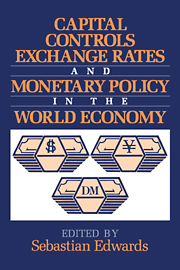Book contents
- Frontmatter
- Contents
- List of contributors
- Introduction
- Part I Monetary policy and stabilization in open economies
- Part II Capital mobility and macroeconomic policy in Europe
- Part III Capital controls and macroeconomic policy in the Asia-Pacific region
- 8 Capital movements, real asset speculation, and macroeconomic adjustment in Korea
- 9 The determinants of capital controls and their effects on trade balance during the period of capital market liberalization in Japan
- 10 Capital mobility and economic policy
- 11 Monetary and exchange rate policies 1973–1991: the Australian and New Zealand experience
- Part IV Capital mobility and exchange rates in Latin America
- Index
11 - Monetary and exchange rate policies 1973–1991: the Australian and New Zealand experience
Published online by Cambridge University Press: 16 October 2009
- Frontmatter
- Contents
- List of contributors
- Introduction
- Part I Monetary policy and stabilization in open economies
- Part II Capital mobility and macroeconomic policy in Europe
- Part III Capital controls and macroeconomic policy in the Asia-Pacific region
- 8 Capital movements, real asset speculation, and macroeconomic adjustment in Korea
- 9 The determinants of capital controls and their effects on trade balance during the period of capital market liberalization in Japan
- 10 Capital mobility and economic policy
- 11 Monetary and exchange rate policies 1973–1991: the Australian and New Zealand experience
- Part IV Capital mobility and exchange rates in Latin America
- Index
Summary
This essay reviews the Australian and New Zealand experiences with monetary and exchange rate policies over the period 1973 to 1991. By way of background, the essay begins by presenting some basic facts about the two economies.
Section 2 deals with the regulatory environment, and the evolution in that environment, in the two economies. This is addressed under several broad headings:
Domestic financial regulation
Controls over capital movements
The exchange rate regime
The regulation of labor markets
The status of the central banks
Section 3 reviews the key theoretical issues that bear on the design of monetary and exchange rate policies. The ground covered includes:
The choice of exchange rate regime
The design of monetary policy
The impacts of domestic financial deregulation
Section 4 addresses the question of how two similar countries like Australia and New Zealand go about choosing the exchange rate regime that best suits their characteristics. Section 5 looks at evidence, for Australia, of the impacts of domestic financial deregulation. Sections 6–8 review in more detail the evolution of monetary and exchange rate policies in Australia and New Zealand.
Section 9 takes as a starting point the fact that the two economies, at about the same time, floated, deregulated their domestic financial system, and abandoned all exchange controls, and then asks how these developments might have affected the capacity of the economy to absorb shocks.
- Type
- Chapter
- Information
- Publisher: Cambridge University PressPrint publication year: 1995



